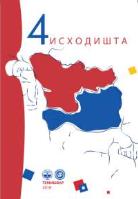ПОЛУГЛАСНИК У ГОВОРУ СЕВЕРНОШАРПЛАНИНСКЕ ЖУПЕ СИРИНИЋ
SEMIVOWEL IN THE VERNACULAR OF THE NORTH ŠAR MOUNTAIN SIRINIĆ ŽUPA
Author(s): Radivoje MladenovićSubject(s): Language studies, Phonetics / Phonology, South Slavic Languages
Published by: Universitatea de Vest din Timişoara
Keywords: the Sirinić vernacular; yers; semivowel; secondary semivowel; reduction of vowels;
Summary/Abstract: The system of the Sirinić vernacular has six vowels, and the semivowel correspondsto the vowel /а/, which is the casein the wider area of the Prizren-Timok, Western Bulgarian and Northern Macedonian dialects. Survival of the semivowel and its articulatory features in this area point to the influence of common Balkan features. Apart from the semivowel, which evelved from the yer sounds,the vernacular of Sirinić also features new semivowels which are of different origins. The etymological vowelis relatively stablein parts of lexemes – in prefixesandthe root(лêко, пrви дêн, да се тêкне, нiкêт нe смо, зêва мoја, пo тêнко, вêшке, у сêн, дêнêс;нe ће сêкрiј е, сêбј Eрем сEно, да изêткам), while it was replaced by /а/ in suffixes(брaтанац, мrтвак / мртaвац, опaнак, мрсoљав). In words whichused to have a semivowelin the weak positionwithin the base, this sound survivesif its lack leaves a consonant cluster which is difficult to pronounce (лêже, мêгла, одмa мêглосaла,бêдњак). Among lexemeswith a secondary semivowelin the final syllableone can findboth/ә/ (мoдêр, за од вEтêр, за од Mгêњ, преко јaрêм, седêмнaес годiне) and /а/ (oстар, вeтар, на oгањ, чeшаљ, oсам брaта). Since most of these semivowels are adjacent to a nasal, plosive or /r/,we can conclude that there is a secondary reduction of a full vowel. This reduction is attested in the same phonemic environment and in lexemes that contain a full vowel. Optionalreduction ofa full vowel to asemivowel, which is certainly common in the languages of the Balkans,is attested in some lexemes (а знêш кaко, сêс мêтку, тêј жeна,бêш нaми,тêмêн,чeкêј да вiдим,тiгêњ волiкви ка кaзêн, на четêрeс дêна,кoсе дêгêчке, одêвно, дêлEко од нaс,зêр мoже,тoј свuдêр, штогoдêр, пoздêр, стoжêр). Some loanwords have also preserved the Turkish semivowel (у санêдце, на јастêце, бaкêр). A number of examples from the Sirinić vernacular confirms the optional use of thenew semivowelat the end of the word, which breaks the distributioal rule of absence of the semivowel at the end of the word. а) The semivowelcan appear at the end of a prepositionas a result of the effort to preserve the phonological status of theobstruent in an intonational whole(одê крoмит, и кодê тaте, терaмо iзêштaле, сêсêжiто прскaмо,сêсê девEра). b) As a tendency toturn monosyllabic words into disyllabic and thus fit them into a rhythmic penultimate stress(омeси лEба врuћê, iшле у кuпê, мичiмо онoјê, у срeдê двoр, о[д] дрeнê, напрaиш’ плuгê).this is sometimes combined with emphatic usage. c) As a means of emphasis (За слaу папрiке, парадaјсê, кuпусê. А за овoјê – настaјмо чMрбу).
Journal: Исходишта
- Issue Year: 4/2018
- Issue No: 4
- Page Range: 211-222
- Page Count: 12
- Language: Serbian

